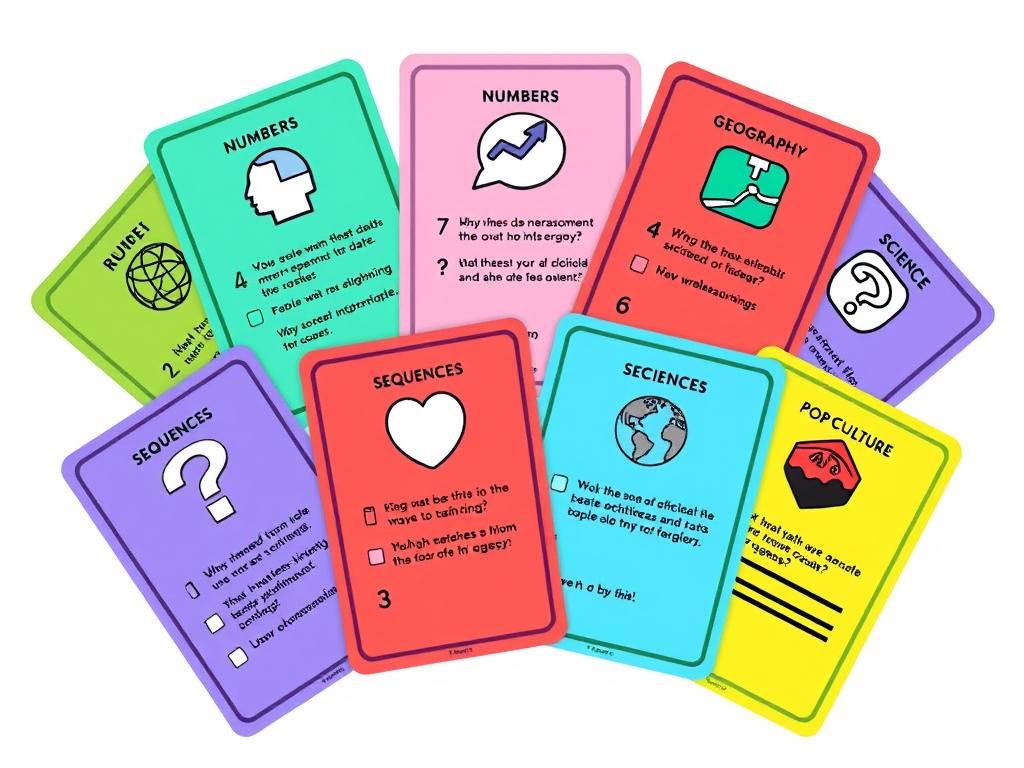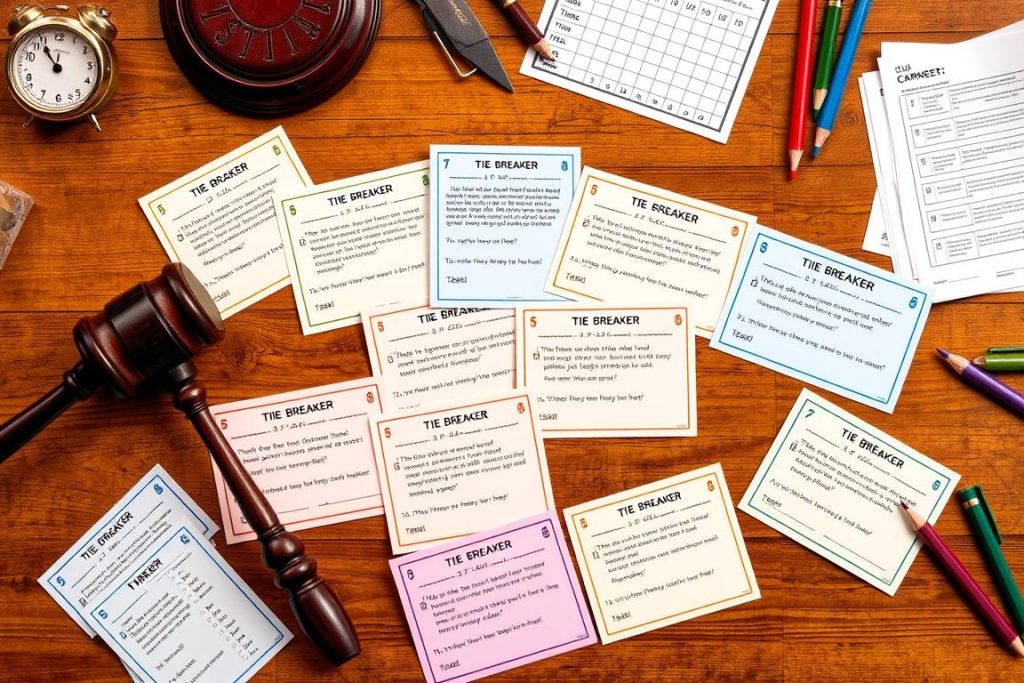Tie Breaker Questions

You’ve crafted the perfect quiz, but what happens when two teams end up with identical scores? Tie Breaker Questions! That’s when you need effective tie breaker questions to determine a clear winner. This comprehensive guide provides everything you need to create, select, and implement the perfect tie breakers for any quiz scenario.
What Makes an Effective Tie Breaker Question?
A great tie breaker question isn’t just any random trivia question. It requires specific characteristics to effectively break a deadlock while keeping the quiz fair and engaging.
5 Essential Characteristics of Effective Tie Breakers
- Numerical precision – Questions with specific numerical answers allow for closest-answer comparisons
- Difficulty balance – Not too easy that it’s common knowledge, not so obscure that it becomes a random guess
- Objective verification – Clear, factual answers that can be easily verified
- Engagement factor – Interesting enough to maintain audience attention during the tie break
- Fairness – Equal opportunity for all contestants regardless of specialist knowledge
The most effective tie breaker questions typically involve numerical answers where the closest guess wins. This approach eliminates the binary right/wrong dynamic and rewards the team with the most accurate knowledge or best estimation skills.
7 Categories of Tie Breaker Questions

1. Numerical Precision
Questions requiring specific numerical answers where the closest guess wins. These are ideal for breaking ties as they rarely result in identical answers.
Example: How many episodes of Friends were made in total? (Answer: 236)
2. Historical Dates
Questions about when specific events occurred, requiring contestants to provide the exact year or date.
Example: In what year was the first Glastonbury festival held? (Answer: 1970)
3. Measurements & Distances
Questions about physical measurements like height, length, distance, or weight of notable objects or landmarks.
Example: What is the circumference of the Earth in miles? (Answer: 24,901 miles)
4. Geographic Statistics
Questions about population figures, country sizes, or other geographic data that require specific numerical answers.
Example: How many countries are there in Africa according to the UN? (Answer: 54)
5. Pop Culture Counts
Questions about quantifiable aspects of movies, music, TV shows, or other entertainment media.
Example: How many studio albums did Michael Jackson release during his lifetime? (Answer: 10)
6. Scientific Measurements
Questions about scientific facts that have precise numerical answers, from atomic weights to astronomical distances.
Example: What is the speed of light in miles per second? (Answer: 186,282 miles per second)

7. Sequence Ordering
Questions requiring contestants to put items in the correct sequence or identify the next item in a pattern.
Example: How many zeroes are in a Googol? (Answer: 100)
30+ Ready-to-Use Tie Breaker Questions

Here’s our collection of tried-and-tested tie breaker questions across various categories. Each question has been selected for its effectiveness in breaking ties while maintaining audience engagement.
| Category | Question | Answer |
| Numerical Precision | How many bathrooms are in the White House? | 35 |
| Numerical Precision | How many bones are there in the adult human hand and wrist? | 27 |
| Historical Dates | In what year did the European Economic Community become the European Union? | 1993 |
| Historical Dates | In what year was the first James Bond film, “Dr. No,” released? | 1962 |
| Measurements | How tall is Mount Everest in metres? | 8,849 metres |
| Measurements | How long was the Titanic? | 269 metres |
| Geographic | How many miles as the crow flies are there between John O’Groats and Lands End? | 603 miles |
| Geographic | What percentage of Earth’s surface is covered in water? | 71% |
| Pop Culture | How many minutes long is the extended cut of The Lord of the Rings trilogy? | 686 minutes |
| Pop Culture | How many songs did The Beatles record in total? | 213 |
Need More Tie Breaker Questions?
Download our free pack of 50 additional tie breaker questions perfect for pub quizzes, family gatherings, or classroom activities.

More Challenging Tie Breakers
- How many minutes are there in a year? (Answer: 525,600)
- What is Usain Bolt’s top recorded speed in mph? (Answer: 27.8 mph)
- How many post offices are there in India? (Answer: 155,015)
- How many times has David Beckham played for England? (Answer: 115)
- How many official languages does the United Nations recognize? (Answer: 6)
- What is the atomic number of Gold (Au)? (Answer: 79)
- How many chromosomes does a typical human cell have? (Answer: 46)
- In miles, how long is the line you can draw with an HB pencil before it runs out? (Answer: 35 miles)
- How many stars are on the Brazilian flag? (Answer: 27)
- How many cities are there in the UK? (Answer: 76)
Format Variations for Tie Breaker Questions
While numerical questions are the most common format for tie breakers, there are several other effective formats you can use to add variety to your quizzes.
Text-Based Questions
The standard format asking for numerical answers, dates, or specific facts. These are easy to administer and judge.
Best for: Most quiz settings, especially when you need a quick resolution.
Visual Tie Breakers
Show an image and ask for specific details, such as “How many windows are on this building?” or “What year was this photograph taken?”
Best for: Quizzes with projection capabilities or printed materials.
Audio Tie Breakers
Play a sound clip and ask questions like “How long was this audio clip in seconds?” or “How many different instruments can you hear?”
Best for: Music-themed quizzes or venues with good audio systems.
Pro Tips for Implementing Different Formats
- Always explain the tie breaker format clearly before presenting the question
- For visual tie breakers, ensure everyone can see the image clearly
- With audio tie breakers, check that the sound is audible throughout the venue
- Consider having backup tie breakers ready in case of further ties
- Allow sufficient time for teams to discuss and submit their answers
Balancing Difficulty in Tie Breaker Questions
Finding the right difficulty level for tie breaker questions is crucial. Too easy, and you might end up with another tie; too difficult, and it becomes a random guess rather than a test of knowledge.
Effective Approaches
- Use questions where most people have some knowledge but few know the exact answer
- Choose topics with wide appeal rather than specialist subjects
- Test estimation skills rather than obscure facts
- Use graduated difficulty – start easier and get progressively harder
Approaches to Avoid
- Extremely obscure facts that nobody could reasonably know
- Questions with binary (yes/no) answers
- Subjective questions without clear correct answers
- Questions that heavily favor certain knowledge areas
Quick Tip: If you’re unsure about difficulty, test your tie breaker questions on a few people beforehand. If everyone gets very different answers, it’s likely a good tie breaker. If most get very close or identical answers, consider something more challenging.
Common Mistakes to Avoid with Tie Breaker Questions
Even experienced quiz masters can fall into these common traps when creating tie breaker questions. Avoid these pitfalls to ensure your tie breakers are fair and effective.
6 Tie Breaker Mistakes to Avoid
- Using easily Googleable questions – In the smartphone era, specific facts can be quickly searched
- Ambiguous wording – Questions that can be interpreted in multiple ways lead to disputes
- Outdated information – Facts that have changed recently (like “tallest building” or “population figures”)
- Binary questions – Yes/no or either/or questions that can’t break ties effectively
- Specialist knowledge questions – Questions that unfairly advantage certain professions or interests
- Forgetting to specify units – Not clarifying whether answers should be in miles, kilometers, etc.
Important: Always verify your tie breaker answers from multiple reliable sources. Nothing undermines a quiz master’s authority more than disputed answers during the crucial tie break moment.
Implementing Tie Breakers in Different Quiz Settings
The way you implement tie breakers should vary depending on your quiz setting, audience, and available resources. Here are some approaches for different scenarios:
How should I implement tie breakers in a pub quiz?
For pub quizzes, announce the tie breaker only when needed at the end. Have teams write their answers on a separate slip of paper. Consider having the tied teams send one representative to answer if you suspect cheating. Announce the correct answer and the winner dramatically to build tension.
What’s the best approach for classroom or educational quizzes?
For educational settings, use tie breakers that reinforce learning objectives. Consider having progressive tie breakers of increasing difficulty. Make the process transparent and explain why certain answers are closer than others to demonstrate critical thinking.
How do I handle tie breakers in online or virtual quizzes?
For virtual quizzes, use the platform’s polling or chat features for submissions. Set strict time limits to prevent googling. Consider using tie breaker questions that require calculation or estimation rather than simple fact-finding. Have participants submit answers privately to the host.
Creating Your Own Tie Breaker Questions
Armed with the principles and examples in this guide, you’re now ready to create your own effective tie breaker questions. Remember that the best tie breakers combine the right level of difficulty with clear, objective answers and an engaging presentation.
Final Tip: Keep a dedicated “tie breaker bank” of questions ready for any quiz you host. Update it regularly with fresh questions and note which ones worked particularly well in practice.

